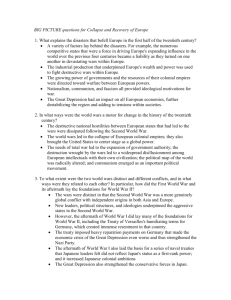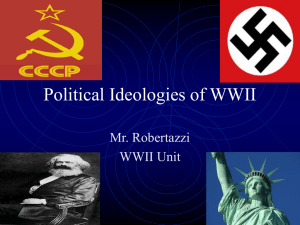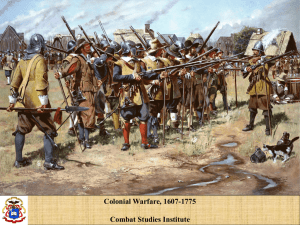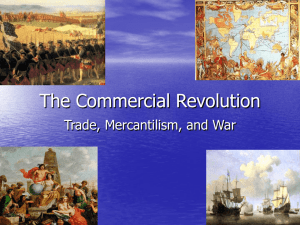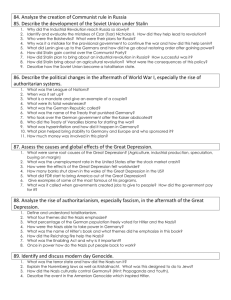Ch 21: The Collapse and Recovery of Europe Margin and Big
advertisement
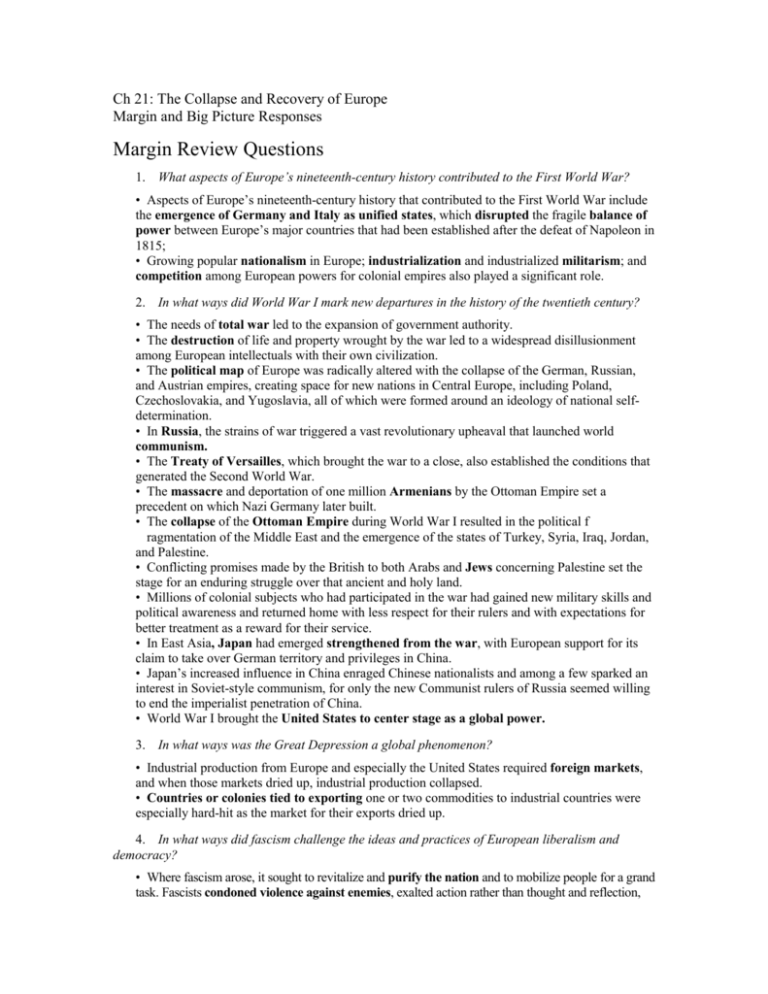
Ch 21: The Collapse and Recovery of Europe Margin and Big Picture Responses Margin Review Questions 1. What aspects of Europe’s nineteenth-century history contributed to the First World War? • Aspects of Europe’s nineteenth-century history that contributed to the First World War include the emergence of Germany and Italy as unified states, which disrupted the fragile balance of power between Europe’s major countries that had been established after the defeat of Napoleon in 1815; • Growing popular nationalism in Europe; industrialization and industrialized militarism; and competition among European powers for colonial empires also played a significant role. 2. In what ways did World War I mark new departures in the history of the twentieth century? • The needs of total war led to the expansion of government authority. • The destruction of life and property wrought by the war led to a widespread disillusionment among European intellectuals with their own civilization. • The political map of Europe was radically altered with the collapse of the German, Russian, and Austrian empires, creating space for new nations in Central Europe, including Poland, Czechoslovakia, and Yugoslavia, all of which were formed around an ideology of national selfdetermination. • In Russia, the strains of war triggered a vast revolutionary upheaval that launched world communism. • The Treaty of Versailles, which brought the war to a close, also established the conditions that generated the Second World War. • The massacre and deportation of one million Armenians by the Ottoman Empire set a precedent on which Nazi Germany later built. • The collapse of the Ottoman Empire during World War I resulted in the political f ragmentation of the Middle East and the emergence of the states of Turkey, Syria, Iraq, Jordan, and Palestine. • Conflicting promises made by the British to both Arabs and Jews concerning Palestine set the stage for an enduring struggle over that ancient and holy land. • Millions of colonial subjects who had participated in the war had gained new military skills and political awareness and returned home with less respect for their rulers and with expectations for better treatment as a reward for their service. • In East Asia, Japan had emerged strengthened from the war, with European support for its claim to take over German territory and privileges in China. • Japan’s increased influence in China enraged Chinese nationalists and among a few sparked an interest in Soviet-style communism, for only the new Communist rulers of Russia seemed willing to end the imperialist penetration of China. • World War I brought the United States to center stage as a global power. 3. In what ways was the Great Depression a global phenomenon? • Industrial production from Europe and especially the United States required foreign markets, and when those markets dried up, industrial production collapsed. • Countries or colonies tied to exporting one or two commodities to industrial countries were especially hard-hit as the market for their exports dried up. 4. In what ways did fascism challenge the ideas and practices of European liberalism and democracy? • Where fascism arose, it sought to revitalize and purify the nation and to mobilize people for a grand task. Fascists condoned violence against enemies, exalted action rather than thought and reflection, and looked to a charismatic leader for direction. They condemned individualism, liberalism, feminism, and parliamentary democracy, all of which, they argued, divided and weakened the nation. 5. What was distinctive about the German expression of fascism? What was the basis of popular support for the Nazis? • German-style fascism was distinct because the Nazis were able to assume police powers more thoroughly than their Italian counterparts were able to achieve, which limited opposition. • Far more so than in Italy, Adolf Hitler and the Nazis used Jews as a symbol of the urban, capitalist, and foreign influences that were supposedly corrupting “true” German culture. • Emphasis on a racial revolution was a central feature of the Nazi program and differed from the racial attitudes in Italy. • In terms of popular support for Nazism, war veterans who had felt betrayed by German politicians after World War I formed an important base of support. • The Nazis also gradually drew support from the middle classes as well as from conservative landowners because of the ruinous inflation of 1923 and then the Great Depression. • By the late 1930s, the Nazis apparently had the support of a considerable majority of the population, in large measure because their policies successfully brought Germany out of the Depression. 6. How did Japan’s experience during the 1920s and 1930s resemble that of Germany, and how did it differ? • Their experiences were similar in that both countries were newcomers to great-power status; had limited experience with democratic politics; moved toward authoritarian government and a denial of democracy at home; launched aggressive programs of territorial expansion; and enacted policies that included state-financed credit and large-scale spending on armaments and public works projects to bring their respective countries out of the Depression quite quickly. • Their experiences differed in that Japan remained, at least internally, a less repressive and more pluralistic society than Germany; no right-wing party was able to seize power in Japan; Japan produced no charismatic leader on the order of Mussolini or Hitler; and Japanese conceptions of their racial purity and uniqueness were directed largely against foreigners rather than an internal minority. 7. In what way were the origins of World War II in Asia and in Europe similar to each other? How were they different? • Both Japan and Germany were dissatisfied with their positions in the international power structure. Both expanded their territories through force, causing tensions with other powers. • However, Japanese leaders felt that they were not being treated as an equal power on the world stage because of racism, while Germans felt that they were being treated unfairly because of their defeat in World War I. • Japan’s initial conquests were driven primarily by a desire to acquire raw materials and other resources, whereas Germany’s were driven primarily by strategic rivalries with neighboring powers. 8. How did World War II differ from World War I? • More than World War I, World War II was a genuinely global conflict with independent origins in both Asia and Europe. • The Second World War was more destructive, with some 60 million deaths—six times the deaths in World War I. • More than half the casualties of World War II were civilians, reflecting a nearly complete blurring of the traditional line between civilian and military targets as compared to World War I. • In World War II, governments mobilized their economies, their people, and their propaganda machines even more extensively than in World War I. • The Holocaust of World War II was an act of genocide that outstripped even the Armenian genocide of World War I in scale. • World War II rearranged the architecture of world politics even more than had World War I. • After World War II, Europe was effectively divided, with its western half operating under an American umbrella and the eastern half subject to Soviet control. • In contrast to the aftermath of World War I, Europe’s role in the world was greatly diminished in the decades that followed World War II, with European colonies in Asia and Africa achieving their independence. • World War II allowed for the consolidation and extension of the communist world in a way that World War I did not. • More effective worldwide organizations like the United Nations and the World Bank took shape after World War II, as compared to the League of Nations that was created after World War I. • The United States took on a more dominant presence on the world stage after World War II as compared to the post–World War I era. 9. How was Europe able to recover from the devastation of war? • • Europe’s industrial societies proved to be resilient. • The major Western European countries took steps to integrate their recovering economies. The United States was in a position to take a leadership role in the West and served as a reservoir of military manpower, economic resources, and political leadership for the West as a whole. Big Picture Questions 1. What explains the disasters that befell Europe in the first half of the twentieth century? • A variety of factors lay behind the disasters. For example, the numerous competitive states that were a force in driving Europe’s expanding influence in the world over the previous four centuries became a liability as they turned on one another in devastating wars within Europe. • The industrial production that underpinned Europe’s wealth and power was used to fight destructive wars within Europe. • The growing power of governments and the resources of their colonial empires were directed toward warfare between European powers. • Nationalism, communism, and fascism all provided ideological motivations for war. • The Great Depression had an impact on all European economies, further destabilizing the r egion and adding to tensions within societies. • 2. In what ways were the world wars a motor for change in the history of the twentieth century? • The destructive national hostilities between European states that had led to the wars were dissipated following the Second World War. The world wars led to the collapse of European colonial empires; they also brought the United States to center stage as a global power. • The needs of total war led to the expansion of government authority; the destruction wrought by the wars led to a widespread disillusionment among European intellectuals with their own civilization; the political map of the world was radically altered; and communism emerged as an important political movement. 3. To what extent were the two world wars distinct and different conflicts, and in what ways were they related to each other? In particular, how did the First World War and its aftermath lay the foundations for World War II? • The wars were distinct in that the Second World War was a more genuinely global conflict with independent origins in both Asia and Europe. New leaders, political structures, and ideologies underpinned the aggressive states in the Second World War. • However, the aftermath of World War I did lay many of the foundations for World War II, including the Treaty of Versailles’s humiliating terms for Germany, which created immense resentment in that country. • The treaty imposed heavy reparation payments on Germany that made the economic crisis of the Great Depression even worse and thus strengthened the Nazi party. • The aftermath of World War I also laid the basis for a series of naval treaties that Japanese leaders felt did not reflect Japan’s status as a first-rank power; and it increased Japanese colonial ambitions. • The Great Depression also strengthened the conservative forces in Japan. 4. In what ways did Europe’s internal conflicts between 1914 and 1945 have global implications? • They led to a decline of European influence on the world stage. • They facilitated the decolonization movements in Asia and Africa after World War II. • They facilitated the spread of communism. • The decline of Western Europe due to the strains of these conflicts transferred leadership of the West to the United States.
